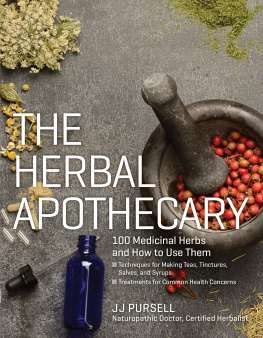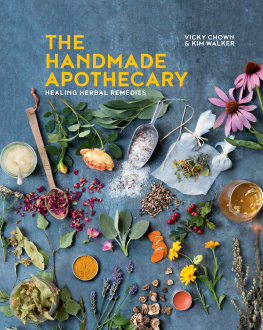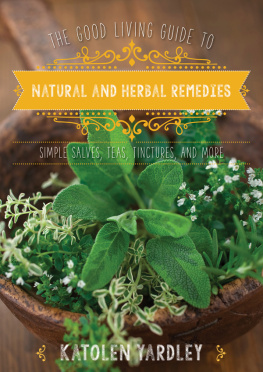Master Recipes
FROM THE Herbal Apothecary

TINCTURES, SALVES, TEAS,
CAPSULES, OILS AND WASHES
FORWHOLE BODY HEALTH
ANDWELLNESS

JJ PURSELL
WITH PHOTOS BY SHAWN LINEHAN
Timber Press
Portland, Oregon
This book is dedicated to Tommy, my sweet, funny, lovable boy.
CONTENTS
INTRODUCTION
WELCOME! If youve found yourself here, its likely because you want to feel empowered to care for yourself and your family with herbs as an alternative to over-the-counter or prescription pharmaceuticals for common ailments. Or maybe you are seeking knowledge about the traditional ways of healing for an ongoing health issue. Perhaps youve already begun exploring herbal medicine and have developed a more serious interestyou are ready to learn and to incorporate herbal remedies into your daily self-care routine. Whatever the reason, I invite you to explore the recipes that follow at your own pace and as you need them.
When I was a budding herbal enthusiast in my twenties, I referred to books very similar to this one but often had to look in multiple volumes to find what I needed. In this book, Ive done my best to create an inclusive, concise reference that is easy to use. The first chapter provides you with basic recipes for the thirteen most useful delivery methods and applications of herbal remediesalong with background about which is best suited to what type of ailment and why. It also describes sixty herbs that are basics in the medicine cabinet. The following thematic chapters provide treatments for ailments from A to Z. Everything you need in order to incorporate herbs into your daily life with the goal of achieving balanced overall health and improved wellness is here.
More and more, we are returning to the ways of self-reliance and traditional medicine. Herbal medicine is an important tool for helping us live healthier lives and actively participating in improving our overall health, naturally. You might use herbs as part of a daily routine or step it up when something acute shows up at your door. Studying the plantstheir ethnobotanical and folk uses and the science of the chemical composition that makes them powerful healing agentsgives herbalists and naturopathic physicians like me a framework for prescribing and creating treatments.

In writing this book, I reflected on my patients and customers most common requests and then created 375 recipes to address these concerns. The recipes will teach you how to manage day-to-day physical complaints such as colds, headaches, stomach upset, and stress. One powerful reason for turning to herbal medicine is that it provides access to healing medicine on the spot, hours or days before you could even get a doctors appointment. If you sprain your ankle playing basketball, for example, and you know that witch hazel leaf and bark can reduce swelling and pain, you can immediately apply a poultice to get ahead of the inflammation process. Another example is having catnip and fennel seed tea on hand to provide instant relief from overindulging at dinner or for general stomach upset.
You may already take herbs, vitamins, and supplements regularly. That market has exploded during the last quarter of a century, encouraging us to take this or that capsule or tablet to regain health and attain vital longevity. The upside to this is that as a result, much scientific research and education has been dedicated to natural health products. This has provided consumers with real information regarding what they are taking and what is realistic as far as expected results.
We are lucky to live in a time when medical science and advanced treatments are available to us. I am personally thankful for Western medicine and hospitals, as I have benefited greatly from modern medicine and feel truly blessed to live in a place where we have relatively easy access to it. I mention this because even though I am dedicated to natural medical practices as a naturopathic physician, licensed acupuncturist, and herbalist, I believe there is a time and place for all types of medical practice. As with most things, finding balance is necessary. What appeals to me about herbal medicine is its accessibility, and one of the reasons I became a naturopathic physician is my belief in empowering others to care for themselves, naturally, whenever possible. I dont believe there should be as large a gap between people and their health care as currently exists in most Western countries.
In my view, all doctors should be teachers, helping their patients learn about their bodies and the ways in which they heal. Too often were simply shepherded through an impersonal health care system and given a quick fix without an education about how to avoid the same problem in the future or any information on how what were taking affects our bodys natural systems. If you arm yourself with the knowledge in this volume, youll be able to reclaim sovereignty over your own health and you will feel confident about treating yourself for any of the dozens of common issues listed here. When we do this, we form a relationship with our body. As our awareness grows of how our body feels when its in balance, we gain keen insight into its form and function, and were better able to identify any imbalances.
How and why herbs work is something of an esoteric conversation. I could provide endless citations of scientific papers on the effects of specific plant constituents, but the total healing effect of an herb on the body is more than the sum of its parts. Lets take echinacea as an example. Echinacea is one of the most researched herbs, with most researchers isolating individual components of the root to identify the actions it produces in the body. This is the most common way for researchers to study an herb, by taking it apart and looking at each part individually. The most prominent parts (constituents) of Echinacea purpurea are caffeic acid derivatives (phenolic compounds), alkamides, and polysaccharides. Research shows that caffeic acid derivatives are potent antioxidants that have important anti-inflammatory effects. Alkamides have stimulatory effects on phagocytosis (they destroy foreign cell types) and trigger effects on the pro-inflammatory cytokines. Cytokines are cell-signaling molecules that aid cell-to-cell communication in immune responses and stimulate the movement of cells toward sites of inflammation, infection, and trauma.
My point here is that research is a great way to identify the individual components of an herb and their actions. This serves an educational purpose and adds to the body of scientific knowledge about plants looked to by those who prefer to rely on science as they consider how to incorporate herbs into their lives. But, and Im guessing you were feeling the but coming, the scientific research method misses a key point: herbs and the greater plant kingdom in general dont work because or when their specific components are isolated. Each plant has an evolved series of complex systems that work symbiotically when all parts function together. And our bodies have evolved right along with them.
Its possible, for example, for one herb to contain elements that individually have contradictory actions such as moistening and drying or astringing and dilating. It seems odd, perhaps, until you think that herbs must be self-sufficient to survive in the wild. They must have many different mechanisms in order to handle various conditions, and they turn to different parts of their own natures as needed to respond to them. Therein lies the magic and wisdom of nature. Plants have adapted to become resilient, which in turn reduces the organisms potential for stress. Yes, stress. Like us, a plant that isnt getting what it needs will produce a stress responseand we all know the impact stress has on our health. Since they cant take themselves to the doctor, plants evolved defense mechanisms.







